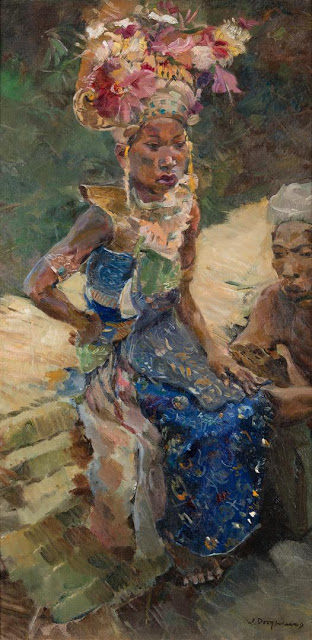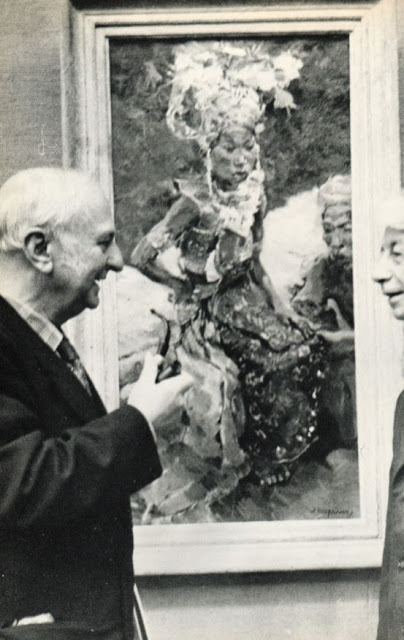
| Willem Dooijewaard (1892-1980) |
Willem Dooyewaard was born in Amsterdam in 1892. After finishing his studies at the Royal Acadamy of Art in Amsterdam in 1912, Dooyewaard travelled through Asia for a period of 20 years. He spent six years at a rubber plantation in Sumatra, before he left for Bali. It was in Bali where he met, and befriended Roland Strasser, in 1922. The two artists worked together and travelled together, defying hardships of all kinds, and observing things that were hardly ever observed before by Europeans. Dooyewaard and Strasser managed not only to visit, but also immortalize on paper and canvas the people of China, Mongolia, Japan, India, and Tibet, to name but a few. Bali, however, takes a special place in Dooyewaards body of work.
Dooyewaards Balinese oeuvre can be divided into three periods: his stays in 1920, 1922-23 and 1931-33. Stylistically, these three periods differ quite a bit; In the second period, Dooyewaard was greatly influenced by Roland Strasser. In 1931, shortly after marrying Jacoba Reinders in Japan, he enjoys a third stay on Bali, initially intended to be Willem and Jacoba’s honeymoon. During this period, his work developed into the impressionist style that Dooyewaard is best known for.
‘Many of Willem’s Balinese paintings were done during the three happy years they were to spend there. They avoided close contacts with the white population in the island and lived alone amidst luxuriant nature, fully accepted by the kind Balinese people. They understood them and loved their culture and customs, the highly mystical religious dances, the fascinating intense surrender of the dancers to their emotions and the beauty of the strictly traditional movements and figures, full of symbolism.’
(Koenraads, 1966, p. 167)
Consequently, Dooyewaards paintings from 1931-1933 depict market vendors, landscapes, and cock fighters. The current lot is a typical example of an early 1930s Legong dancer, most of which have been portrayed by Dooyewaard full length onto one-meter high canvases.
We see a young girl, fully dressed and made-up in ceremonial attire, getting mentally prepared for her Legong dance performance. The look in her eyes is determined, her expression noble, and her facial features and posture don’t betray any tension. She is wearing a magnificent blue kain prada (a dress with goldleaf print), a single lamak (breast cloth) through which she can be determined a Legong dancer, a gilt sesimping vest, and gilt headgear, elaborately adorned with frangipani (small white flowers) and kembang sepatu (red hibiscus flowers). The impression of a Balinese man Dooyewaard portrays, squatting next to the Legong dancer, might be her father or uncle, assisting her before and after the performance. Although the colours and decorative elements of the girl’s dress seem exaggerated to most Western people, Dooyewaard merely portrayed the beauty he witnessed on Bali:
‘Dooyewaard did not imagine of this fairytale island any Far Eastern dreams or phantastic depictions. He considered reality to be sufficient, and generously visualized this reality, in vigorously, broadly painted colour gamuts.’ (Theodoor van Lelyveld, Willem Dooyewaard op Bali, in Nederlandsch Indië Oud en Nieuw, November 1936)
 |
| Willem Dooyewaard in front of the painting, 1966. |
In 1966, Dooyewaard can be seen on a photograph, chatting with a friend, with the current painting displayed in the background. It must have been in this period, that the painting he cherished for such a long time, was acquired by the current family. Their daughter has actually mentioned that her parents ‘would hasten to help out a fellow artist short of money: a painting was offered in return. In this way they quietly accumulated paintings by the Dooyewaard brothers, Bonnet and others, which never came onto the market or were seen by the outside public.’
Now, almost 90 years after its creation, a unique opportunity is offered to acquire this fresh-to-market Balinese capolavoro by Willem Dooyewaard.
Gianni Orsini MSc. May 2019
Literature:
Dhaimeler, D.H., W. Dooijewaard, a Dutch artist in Indonesia,
Jakarta 1992, p. 14 (illustrated in a photograph with
the artist, circa 1966, see image).
Literature reference:
Orsini, G., Soul Brothers, Twin Artists – Strasser and
Dooijewaard in Bali and beyond, in: Transcultural Expressions
Tahiti-Bali, Museum Pasifika, Bali, 2017, pp. 192-205,
compare with a similar painting by Strasser, possibly the
same model, on p. 192.
Exhibited:
Possibly exhibited at Pulchri Studio, The Hague: Bali,
Schilderijen en tekeningen van Willem Dooyewaard, 22
December 1933 – 14 January 1934, as no. 3, ‘Gereed voor
den Dans’ (‘Prepared for the Dance’), priced at 400 Dutch
guilders.
Provenance:
Acquired directly from the artist, in Laren, probably in the
1960s; thence by descent.
More information about our auctions of Indonesian paintings(veilingen van Indonesische schilderijen):
René de Visser
Zeeuws Veilinghuis
rene@zeeuwsveilinghuis.nl
www.zeeuwsveilinghuis.nl

